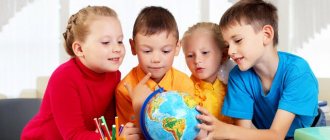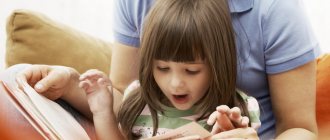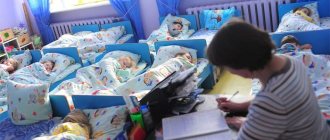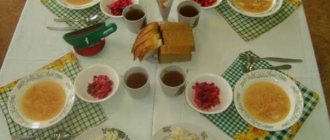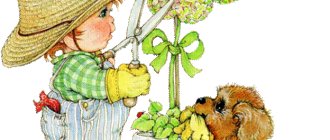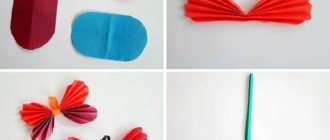The meaning and goals of school preparation classes in kindergarten
The mission of the kindergarten in preparing the student for further education at school is to:
- full age-appropriate physical, mental, moral and aesthetic development;
- implementation of special preparation for subsequent mastery of school subjects.
Both of these goals are consistently implemented from early childhood, and in the senior and preparatory groups (children 6–7 years old), direct educational activities (DEA) become more focused and are implemented within the framework of special classes.
This is interesting. The main goal of all classes with children 6–7 years old is to prepare for subsequent schooling. That is why the age group is called: preparatory to school.
Preparing for school includes not only the child’s intellectual development, but also physical, emotional-volitional and social-communicative development.
Objectives within the overall goals
The objectives of preparing children for school are:
- fostering curiosity, interest in knowledge and ways of obtaining it (for example, children learn to look for the necessary information in reference books);
- development of attention (voluntary and involuntary);
- developing ideas about the lesson as a form of organized activity that involves attention to the words and actions of the teacher, as well as the obligatory fulfillment of the tasks given to him;
- the formation of skills of organized behavior in the process of direct educational activities, games (these skills teach the child to be responsible for his choice, for example, when the child chooses a role in the game, and also develops the ability to work in a team);
- development of important personal qualities - responsibility, perseverance, diligence, which is manifested in the child’s desire to gain knowledge and apply it in practice;
- nurturing one’s own experience in activities, as well as awareness of oneself as part of a team and mastering methods of actively influencing comrades (for example, kids learn to argue their point of view to other children).
Thus, the acquisition of knowledge and the development of skills in preschoolers occurs through 2 important areas of activity:
- through communication with peers and adults (when performing routine tasks, during walks, organizing leisure activities, etc.);
- through an organized educational process (during special classes with older preschoolers 1–2 times a week, depending on the content of the program in which a particular kindergarten operates).
This is interesting. In modern literature on psychology, the idea is actively defended that about 80% of a child’s intelligence is formed before he reaches the age of eight.
Preparing for school gives preschoolers the opportunity to try on the new social status of a student
Video: Dr. Komarovsky’s recommendations for preparing a child for school
Types of school preparation activities
Since preparation for school is cross-cutting in nature, it is implemented within the framework of all classes defined by the preschool educational institution program. If we talk about the implementation of special training for children 6–7 years old, then it takes place in classes on:
- speech development (children learn to construct logical monologue statements, master dialogue skills, etc.);
- literacy training (children master primary writing skills);
- reading (children listen, analyze works reinforced by the educational program, and also learn to read independently);
- mathematics or the formation of elementary mathematical concepts (children master counting up to 100 and basic arithmetic operations within 10, learn the names and characteristics of simple geometric figures, learn to distinguish shapes and sizes, etc.);
- familiarization with the environment (preschoolers gain an understanding of the essence of natural phenomena, learn to observe nature, recording their experiences in nature calendars, and also become familiar with the concept of work activity);
- artistic and aesthetic development (pupils learn the algorithm for working on a creative task, that is, they think about the idea, select materials and only then begin to implement it, following a certain sequence of actions).
In most cases, the kindergarten opts for the option of conducting comprehensive classes to prepare for school, which combine elements of all of the above educational areas, that is, educational areas are integrated into one time period. In this case, the emphasis is necessarily placed on one of them, for example, speech development or mathematics.
This is interesting. According to the stage of mastering the knowledge, skills and abilities established by the program, which are included in the indicators for determining readiness for school, the following types of classes are distinguished: first, second, etc.
As a rule, integrated classes are held in kindergarten to prepare for school, in contrast to early development centers, where fragmentation into separate educational courses also has material benefits
Video: preparing for school (mathematics)
Video: preparing for school (literacy)
How to personalize tasks
All children are different - this is an axiom. At the same time, the teacher’s task is to ensure that each child receives this or that information as fully as possible. To do this, the teacher needs to select a “key” for each student, that is, techniques that activate the child’s leading channel of perception:
- vision;
- hearing;
- tactile sensations;
- movement.
Therefore, in every lesson the teacher uses:
- visual aids (pictures, posters, etc.);
- verbal techniques (riddles, poems, etc.);
- games (didactic, that is, aimed at cognition, active, aimed at physical training, as well as theatrical, with the goal of liberating children);
- practical techniques in which students creatively comprehend their experience and acquired knowledge.
Such a variety of ways to organize children’s activities helps each of the students “find themselves.” For example, if a child does not want to draw with everyone else, then he can be given the task of describing what a friend has drawn. If a child easily and quickly learns poems, then he can be assigned the role of a partner in conducting the lesson, leaving him to read the rhymed lines of the epigraph at the beginning of the lesson. By the way, the technique when a child plays the role of a teacher is the best motivation for children of senior preschool age who strive to become adults as quickly as possible.
If there are passive children in the group, then they need to be distributed into mini-groups, “connecting” them to the active ones. As a result of the mutual exchange of work experience, the children will be more receptive to educational material.
When distributing children into pairs, you should remember that you cannot combine two passive children together
School project “On the threshold of school”
Type of project: long-term, information-practice-oriented, psychological and educational.
Age and composition of participants: pupils of senior preschool age, their parents, teachers.
Time planned for project implementation: 8 months.
Problem: immaturity of the mental processes of older preschoolers, and as a consequence - a low level of psychological readiness for schooling, a lack of psychological knowledge of parents and teachers.
Relevance of the project.
Being ready for school does not mean being able to write and read, you need to be psychologically ready for school!
Is your child ready for school? He is able to be attentive (attention), skillfully solve logical problems (thinking), has a firm hand for writing (motor skills), can easily navigate a piece of paper (orientation in space left, right, top, bottom), can prove his opinion, give arguments , wants to go to school for knowledge, not a beautiful backpack (motivation for learning), treat adults politely, the cognitive side of studying is developed! If you honestly answered “YES” to all the questions, then your child will be a successful student at school, but if “NO”, then your future student has time to prepare for a new stage in life - school!
Educational activity is difficult for a preschooler and an automatic transition to it without the child’s preliminary preparation is simply not possible.
But preparation is needed not only for the child, but also for his parents, especially those whose first child goes to school. How to get your child ready to study? How to choose primary education from the many offered, focusing on the characteristics and abilities of your child? How to reduce anxiety levels in yourself and your child? What “right” shoes and backpack should a first-grader choose to stay healthy?
The mental health of children during the transition from kindergarten to school has not attracted the attention of adults for a long time. Meanwhile, entering school completely changes the child’s life. At school, the child finds himself in new social conditions.
A child who is poorly prepared for learning already in the first grade begins to lag behind his peers, which contributes to the formation of low self-esteem and subsequently leads to persistent school failure and maladjustment.
The proposed project will help:
- Psychologically prepare the child for the transition from play activities to educational activities;
- To develop the mental processes of the future first-grader: attention, memory, thinking, perception;
- Prepare the child’s hand for writing (fine motor skills);
- Form a system of relationships for the preschooler (to himself, adults, school);
- Strengthen the emotional sphere of both the child and his parents (adequate response to the emotions of others);
- Master language as a system for receiving and transmitting information (monologue, dialogue);
- To form the volitional and motivational components of the future schoolchild;
- The orientation of each child towards independence, self-confidence, success and self-efficacy (confident in his actions).
- To increase the cultural level of parents in the field of the child’s psychological readiness for school;
- Provide the necessary knowledge to parents of students and teachers about the proper selection of shoes, school backpack and accessories;
- Teach ways and means of reducing anxiety;
The planned PROJECT lessons with children are filled with various game tasks that are focused on the development of the child’s cognitive mental processes, which is a necessary basis for mastering any educational material: counting, reading, writing. Grouped by theme, season, calendar holidays. Visual material, musical accompaniment of thematic games, and reward elements were used.
Meetings with parents are informative, increase the level of knowledge in the field of child psychology, preserve the child’s health and certainly force adults to think about the psychological well-being of their child.
When a child enters school, his usual lifestyle changes, and new relationships with people arise. A change in environment may be accompanied by an increase in anxiety and a decrease in activity. The result of this may be the emergence of inadequate coping mechanisms, which are commonly called school maladjustment. One of its main manifestations is an increased level of anxiety. Under unfavorable conditions (anxiety in children, fears in parents), anxiety turns into a stable character trait. Closer to the age of 7, we can talk about a certain emotional mood with a predominant feeling of anxiety and fear of doing something wrong. In this regard, the issue of successful adaptation of the child to school is acute.
A strong relationship has been established between mental health disorders and children's educational success. By the time a child enters school, he should have an idea of what awaits him and how learning takes place. And the most important thing. He must have a desire to learn. If a child is not ready for a new society, then even if he has the necessary skills and abilities, it will be difficult for him.
It is often difficult for children to analyze their experiences and their attitude towards schooling. By the age of 7, half of children (especially boys) are not psychologically ready to start school. There is immaturity of regulatory functions, voluntary behavior, memory, and speech are difficult. Children of senior preschool age develop fears, anxiety, and uncertainty before entering school. Excessive demands are placed on the child’s behavior, which he is unable to meet. This also increases anxiety and lowers self-esteem.
Objective of the project.
Increase the level of individual development and develop students’ interest in school. To form a positive attitude towards the upcoming training, to prepare for the adoption of a new social role - the position of a “school student”, to increase the literacy and competence of parents and teachers on the issue of preparing children for school.
Project objectives
Children:
- Formation of children's psychological readiness for school through the development of mental processes.
- Preparing the hand for writing through the development of fine motor skills;
- Formation of a preschooler’s system of relationships (to himself, adults, school);
- Strengthening the child’s emotional sphere (adequate response to the emotions of others);
- Master language as a system for receiving and transmitting information (monologue, dialogue);
- To form the volitional and motivational components of the future schoolchild;
- The orientation of each child towards independence, self-confidence, success and self-efficacy (confident in his actions).
Parents, Teachers:
- Conducting pedagogical education for parents of future first-graders on the issues of children’s readiness for school;
- Training parents of pupils in ways to relieve anxiety;
- Familiarization of parents with the basics of psychology of a child of senior preschool age and with methods and techniques of positive attitude of children to the “school position”.
- Communication with parents of students on the topic of the project on the KAZINOPA website, topic: “BOOMERANG”
Project implementation principles
- Purposefulness of the process of psychological development based on the age characteristics of children;
- Scientifically based combination of different types of activities;
- Unity of content, forms and methods of work;
- Personality-oriented approach in the process of developing a positive attitude towards school in preschool children;
- The principle of co-creation of children, teachers and parents in the joint process “children – parents – employees”;
- The principle of systematicity and consistency.
Project subjects
- Educators;
- Children of senior preschool age;
- Parents.
Project implementation period
Academic year 2012 – 2013
Expected Result
- The level of “psychological readiness” in older children for school has increased;
- Development of fine motor skills;
- Reducing anxiety in children and their parents;
- Increasing educational motivation in children for schooling, through the desire for success;
- Increasing the competence of parents on preparing children for school;
- Development of booklets and consultations for parents.
Project organization
Stage 1. Formulation of the problem.
Hypothesis
The development of mental processes through classes with the children themselves, increasing the level of psychological literacy among parents of students and teachers will make it possible to effectively influence the level of individual development of each child, and as a result, competently increase the psychological readiness of children for the primary school level.
Stage 2. Organization of project implementation.
Tasks:
- Conducting a diagnostic examination of children “Psychological readiness for school (methods: Agafonova, Jierasek “School Maturity Test”). Identification of the individual level of development of children.
- Joint educational activities of a teacher-psychologist with children: Classes according to the author’s Program: “On the threshold of school” (October - May)
- Conducting conversations and individual consultations for parents and teachers “Psychological readiness for school” using EER, internet (preschool educational institution website on Kasinope).
- Seminars “Adaptation”, “Time of Cooperation” - psychological readiness for school.
- Attending parent group meetings in order to unite Project participants and interest in the work.
Stage 3 is final.
Tasks:
- Control diagnostics of pupils to study changes in the level of individual development of mental processes.
- Individual counseling for parents and teachers as part of the Child Readiness for School Project.
Expected Result:
- Dynamics in the individual development of children;
- Improving the psychological culture of parents and teachers
- Mastering ways to reduce anxiety.
- Competent choice by parents of an educational institution, focusing on the abilities, preparedness and characteristics of their child.
Product of project activity: monitoring study of the level of dynamics of individual development of mental processes of older preschool children in the form of graphs, diagrams, analytical reports.
Receptions in classes to prepare for school in kindergarten
When preparing for school, it is very important to introduce children to all possible types of pedagogical interaction, in other words, to teach them to work in conditions where the teacher uses various methodological techniques. In the practice of preschool and school education, 4 groups of methods of interaction with students are used.
Verbal techniques
Since the word plays a key role in the development of a child, verbal methods of interaction with children in the process of educational activities are leading. By listening to the teacher’s speech, as well as entering into dialogue and composing monologues, the children learn to find a common language among their peers. In addition, we must not forget that children 5–7 years old, listening to adults, form their own speech image, which largely determines the successful socialization of preschoolers and future first-graders.
Explanation
This verbal technique accompanies any type of activity of preschoolers. Moreover, even if we are talking about repeated instructions for performing a routine moment (for example, behavior at the table or getting ready for bed), an explanation is still necessary, at least in the form of instructions from simple sentences.
It is worth special mentioning the use of explanation as a motivational technique. Children of senior preschool age try to imitate adults in everything, therefore, for speech development and inclusion in one or another type of activity, verbal techniques traditionally used by the teacher can be left to the pupils. For example, give the task to explain to your comrades the procedure for completing an addition example or the progress of working on a craft.
Conversation
In this format, it is possible to build not only the test of material mastery that is accepted in pedagogical practice. With the help of leading questions on the topic, children can create an algorithm for completing a particular task.
For example, before starting to draw, I talk with my students about the following questions:
- What do you need to paint?
- How should we prepare the workplace?
- Why is it important to organize your work correctly?
This is interesting. It is very important to include “why” questions in the conversation, that is, problematic ones. They teach children to think, analyze, and draw conclusions.
Problematic questions should be included in any dialogue with children.
Riddles and poems
Typically, these techniques are used to motivate children to get them ready to complete a task. But in direct educational activities, riddles can also be used to practice the material studied. For example, having completed the repetition of vowels in class, I invite the children to repeat the material they have learned by solving riddles:
- “Watermelon” and “Almanac” begin with this letter. We all see it in almost all words. (The letter a").
- The goat bleats: “Me” and “me”, He only knows “Em” and ... (“e”).
- The hedgehog dozed off under the tree, Someone robbed the animal: Instead of “Hedgehog” there is only “hedgehog” lying near the tree. Where the maples are near the fishing line, “Yolka” became simply “elka”. Come on? How many of you found out what letter the hedgehog slept through? (Letter “e”).
- The first in the words “Needle”, “Oriole”, “Turkey”, “Caviar”. (Letter “i”).
- “Cloud”, “Glasses”, “Wasp”, “KNIFE”, “pendant” and “sausage”... Children have known for a long time that the letter ... (“o”) is similar to a steering wheel.
Poems can also be used for several purposes:
- remember what you have learned;
- get acquainted with new material;
- repeat acquired knowledge, skills and abilities at home (poems are often used as homework).
With my students when studying the topic “Time. Days of the week" we remember the order of the days of the week along with the rhyme:
- On Monday I did the laundry, and on Tuesday I swept. On Wednesday I baked kalach with honey, and on Thursday I played ball. On Friday I washed the dishes, and on Saturday I bought a cake. On Sunday I rested and read good fairy tales.
Reading
In the preparatory group, most of the children can read, so they can be given the task of reading short passages on the topic. At the same time, it is important that the text as a whole and all the words in it are understandable to the children. Reading can be used as a means of implementing a heuristic approach to education - when children find the information they need on their own. For example, in work on preparing for school, this could be understanding the watering regime for indoor plants.
This is interesting. The older the children become, the less they should read aloud, and the more they should involve themselves in this type of activity. Some psychologists claim that this technique contributes to the rapid development of reading skills.
Reading small information blocks by children stimulates other children to quickly master this important skill.
Fairy tales
I use short story sketches to motivate children, to distract them from their current studies and attract them to a common activity. For example, in order to motivate children to engage in educational activities, I offer my kids a fairy tale about Masha, who was afraid to go to school. “Once upon a time there was a girl Masha. She really wanted to grow up quickly and go to school to learn a lot. Masha thought that school would be very fun, there would be a lot of games and entertainment with friends. However, when Masha went to school, she became very scared, because there were unfamiliar children around, and the teacher explained to everyone that they should behave quietly and calmly. And then there were lessons in which the girl did not succeed, and she was afraid that the teacher would scold her. Masha came home in tears; school turned out to be completely different from what she had dreamed of. The mother explained to her daughter that we are all afraid of the unknown, and everyone can make mistakes, there is nothing wrong with that. The next day Masha went to school again, where she made friends with the guys and learned a lot of new and interesting things.” After the children have listened to the fairy tale, you can check your understanding of the plot using questions: Why did Masha want to go to school? What was Masha afraid of? What did the girl's mother say?
A teacher using fairy tales as a method for motivation must take into account that:
- the plots should not be too long, with a large number of characters (2-3 heroes are enough);
- the development of the action should not be overloaded (that is, 1–2 plot twists are quite enough);
- fairy tales must be accompanied by visual aids (pictures or toys from whose perspective the story is told).
Plot sketches should not be long, otherwise preschoolers may lose interest in further activities.
Visual techniques
Children perceive most information from the world around them through the visual channel. Therefore, visual techniques are actively used in preparation for school. Among the most effective are:
- pictures (illustrations accompany not only plot narratives, for example, fairy tales, but also routine moments, for example, the order of folding clothes in the closet after a walk);
- diagrams (this type of clarity is very important for mastering the skill of writing, since in the diagrams kids see the sequence of writing out the elements of letters);
- display (the best way to make children feel involved in a particular activity is to show that an adult is also passionate about it, for example, by completing an application on the topic “Types of transport. Airplane”, the teacher and children can arrange a competition to see who can come up with the most realistic or similar per sample model);
- demonstration (video materials can be used productively when developing topics in mathematics, speech development, and literacy).
Video: learning to add and subtract within nine
Practical techniques
To consolidate the studied material, practical techniques are traditionally used that demonstrate creative comprehension of information:
- drawings;
- applications;
- crafts.
These types of work can be united by a common task - creating a project on the topic. For example, “I am a future first-grader.”
Photo gallery: examples of drawings on the topic “I am a future first-grader”
In the drawings, children depict not only the school building, but also their future image of a first-grader
In drawings, preschoolers express their expectations from school
In the projects, children demonstrate their vision of the image of the school
Parents participate in the creation of the project, providing mediocre assistance, for example, designing inscriptions
Observation
The use of this practical technique is important for the development of a heuristic way of acquiring knowledge by children. That is, the guys themselves obtain information, analyze it and, in connection with this, formulate certain conclusions. The function of the teacher in this case is limited to helping in generalizing and systematizing the material. Observation is organized during a walk or in the form of experiments in a group.
Table: file of observations in preparation for school (fragment)
| Subject | Target | Description |
| Monitoring air temperature changes |
| Children record air temperature in August and September. They come to the conclusion that the first month of autumn is colder than the last month of summer by an average of 5 degrees. |
| Observing the snow melting process |
| Children observe the speed of snow melting and determine that it melts faster near tree trunks, as the roots absorb water. |
| Tree watching |
| Children watch the trees in the area, where sap is released from cracks in the bark - a delicacy for insects. Based on the existing knowledge about the movement of water along the trunk, the guys come to the conclusion that under the influence of spring heat, water with useful substances from the ground moves along the trunk to the branches and buds, from which leaves will soon appear. |
Gaming techniques
Game techniques are actively used in preparing for school, since play is the leading activity of preschoolers.
Didactic games
This type of games is actively used when organizing GCD, since it allows:
- get acquainted with new information;
- practice and consolidate acquired knowledge, skills and abilities;
- repeat the studied material.
There are 2 types of educational (didactic) games:
- content-oriented game actions;
- based on game material.
Didactic games based on game material cultivate perseverance in preschoolers
Table: types of didactic games in preparation for school
| Type | Type of game | Name | Goals | Description |
| Content driven games | Logical | "Flowers in the Flowerbeds" |
| The teacher distributes paper flower beds of round, rectangular and square shapes to the children. Gives out 3 different colored flowers. Children arrange flowers, focusing on the story: “The red flowers did not grow in a square, but not in a round flowerbed. And the orange ones are not on the round one, but not on the rectangular one either. Plant the flowers correctly." |
| Verbal | “I - for you, you - for me” |
| The teacher pronounces the sentence, the children count the number of words in it. Whoever answered quickly and correctly wins and says his sentence, the words of which are counted by the rest of the participants. | |
| Sensory | "Name it in parts" | Practice the skill of composing an image from parts and, conversely, decomposing the whole into parts. | Children put together pictures from individual parts (for example, wheels, body, cab - truck). Then they talk about the purpose of each element. | |
| Musical | "Guess what it sounds like" |
| The teacher plays a musical instrument behind a screen, and the children guess what it sounds like. | |
| Material-oriented games | Desktop-printed | "Seasons" |
| Children quickly group pictures with the names of months, signs of seasonal changes, and then compose a coherent story about the seasons. |
| Playing with objects | These are mainly games with natural materials. For example, count the number of acorns for a squirrel and a hedgehog, distribute equally, give one of the characters more, etc. | |||
| Interactive | These games use computer technology. So, in math classes to prepare for school, children can be offered the game “Masha and the Bear”, in which children, together with the characters of their favorite cartoon, complete addition and subtraction tasks. | |||
Outdoor games
Health-saving teaching methods are the main ones in working with preschool children. For their practical implementation, outdoor games are actively introduced into all elements of the educational process, which also fulfill the task of maintaining the general emotional tone in the group.
Outdoor games lift the spirits of both children and adults
Table: types of outdoor games used in school preparation classes
| Skill to be practiced | Name of the game | Goals | Progress of the game |
| Running in different directions, jumping | "Blind Man's Bluff" |
| Children stand in a circle, one participant is blindfolded. He turns around himself several times. Then the participants scatter, and the trap, with its eyes closed, tries to catch one of them, focusing on steps or other sounds. |
| Spatial orientation | "Trap with Ribbons" |
| Children stand in a circle, each with a ribbon under their belt. At the signal, the participants scatter, and the trap tries to snatch the ribbon. According to a conventional sign, the children stop, and the trap counts the number of players caught. |
| Forming a sense of balance | "Fishing rod" | Learn to jump over a rotating rope. | The driver throws a jump rope across the floor, the rest of the participants must jump over it, maintaining their balance. |
| Ability to imitate | "Ocean is shaking" |
| Children stand in designated circles and perform any movements. The driver walks between the players, periodically puts his hand on the participant’s shoulder and, at the signal “The sea is rough,” performs a movement that the player must repeat. At the same time, the driver takes the player away from the circle. At the signal “The sea is calm,” the participant must run to his circle. If he doesn’t have time, he becomes the driver. |
| Development of attention | "Be careful" |
| Children stand in a line, with several objects in front of them at a certain distance: cubes, skittles, flags, etc. At the driver’s signal, the participants run to the objects and halfway along they hear an indication of which one they need to take. The one who correctly followed the instructions wins. |
| Practicing climbing and crawling skills | "With the ball under the arc" |
| Children take turns crawling under arches about 40 cm high, while pushing a medicine ball with their heads. The number of arcs is determined by the area of the space. |
| Agility training | "The Kite and the Mother Hen" |
| Children stand in a column, the first participant is the hen, the rest are chickens. According to a conventional sign, a “kite” flies out of the nest and tries to grab the chick standing last in the column. The hen runs away with the rest of the participants, turning so as to protect the “chicken”. The column cannot be disengaged. |
Theatrical games group
When preparing for school, several types of theatrical games are included in the educational process:
- role-playing games, in which children, based on personal experience, act out everyday situations (at a doctor’s appointment, in a lesson at school, etc.);
- dramatization, where children perform play actions based on the instructions of the “director,” that is, a teacher or friend (for example, skits based on read fairy tales, participation in thematic matinees, etc.);
- director's games, that is, performing game actions based on an invented plot (for example, acting out saving hares from a flood in the forest on a flannelgraph);
- finger games are exercises for training fine motor skills aimed at activating speech centers.
By playing out various situations and fairy tales, preschoolers learn new behavior patterns, become more independent and self-confident.
By playing school, children in a safe environment become familiar with the roles of students and teachers.
Methodology for conducting classes to prepare for school in preschool educational institutions
To achieve the set goals and objectives, the teacher must not only wisely select the content of the lesson, but also logically build its structure.
Temporary GCD plan for school preparation
Like other classes with older preschoolers, the school preparation lesson lasts 25–30 minutes. This time frame includes 4 stages of work:
- Updating basic knowledge (introductory stage) - 2–3 minutes. The teacher motivates the children to work, the children repeat the material learned earlier, and check their homework if this type of work is expected.
- The main stage is up to 15 minutes. During this time, children become acquainted with new material, combining the information received with what they have already mastered. In addition, the main stage includes physical education (breathing exercises, finger games).
- Consolidation of what has been learned - up to 8 minutes. The studied material is systematized using practical techniques (making applications, drawings, etc.).
- The final stage is up to 4 minutes. The teacher comments on the work of the group as a whole and each child individually. Children evaluate themselves in class, that is, reflection is carried out.
An integrated lesson usually includes tasks in literacy, mathematics and environmental awareness.
Table: summary of the integrated educational activity “Back to school soon!” in the preparatory group (fragment)
| Author | Kharlanova I., teacher, kindergarten No. 10 "Bell", Kolomna, Moscow region. |
| Introductory stage | V.: Guys, let’s say hello to our guests and give them our smiles. Now everyone look at me and give me your smiles. Good morning, dear children and adults. This morning a package arrived to us, now we’ll see who it’s from (these children left our group for school a year ago). He opens the parcel and reads the letter: “Hello, dear friends! I'm doing well, I really like studying at school, I've made a lot of good friends. I try to study at “4” and “5”, and at school it is very important to be kind so that you have many friends. I know that you will also go to school soon, and therefore I have given you interesting tasks. When you complete them, a surprise awaits you. Good luck and success, see you soon." V.: I know that you want to go to school, but why? Children's answers...> |
| Main part | <… V.: Let’s see what the task is... You need to answer the questions with complete answers, are you ready?
Q: Let us remember what parts the task consists of? (From the condition and question).
V.: Well done! Let's create a problem based on the picture. Tell us your task. (Children's answers). <…> Do a graphic dictation:
V.: Let's see what's in the next envelope. You need to answer the questions:
|
| Consolidation of what has been learned | <… V.: Look: syllables are written on the envelopes. Let's try to make a word out of them. Children form the word “KINDNESS” and read it. Q: Guys, what do you think “kindness” is? <…> Children read poems about kindness and politeness. |
| The final stage | <… V.: Let us never forget kind, polite words. Let's say them to each other more often, speak kindly, gently, quietly, looking into the person's eyes. At the same time, smiling, because a smile makes a gloomy day brighter. A beautiful word that helps you live. All tasks have been completed. You handled everything well. What did you do today? (Children's answers). Look, we have another letter. “Well done! You did an excellent job with all the tasks and deserve a surprise. See you at school." The teacher gives the children medals - emoticons. V.: Thanks to our guests, teachers, thanks to our guys! |
| Quote from: https://www.maam.ru/detskijsad/konspekt-integrirovanoi-nod-na-temu-skoro-v-shkolu-v-podgotovitelnoi-grupe.html | |
Video: open integrated lesson in a preparatory school group
https://youtube.com/watch?v=YlOrFybQODI
Preparing for school is a long and systematic process that is carried out in kindergarten, starting from the first junior group. But if in primary and middle preschool age children master social and communication skills that are of key importance for the subsequent educational stage, then in older groups this work takes on the character of direct educational activity, that is, it is organized in special classes. As a rule, the teacher plans these lessons as integrated, that is, including work in all educational areas in accordance with the Federal State Educational Standard.
Pedagogical project “Soon to school” (for preparatory group)
Municipal budgetary preschool educational institution of the Balashikha urban district
"Kindergarten No. 42 "Lukomorye"
PEDAGOGICAL PROJECT
"GOING TO SCHOOL SOON"
For children in pre-school group No. 8 “Octopus”
Balashikha
2019-2020 academic year
Project passport
Project name:
"Soon to school"
Project type:
cognitive - creative, informational.
Duration
: long term
Project participants
: children of the preparatory group, teachers, parents, music director, physical education instructor.
Educational area
: "Cognitive development".
Integration of educational areas:
“Social and communicative development”, “Speech development”, “Artistic and aesthetic development”, “Physical development”.
Relevance of the project
Currently, the school is solving complex problems of education and upbringing of the younger generation. The success of schooling largely depends on the level of preparedness of the child in the preschool period.
Psychological and pedagogical research examines issues of special and general psychological readiness of a child for school. According to scientists, one of the aspects of psychological readiness is the personal readiness of a preschooler for the upcoming learning, which is expressed in the motives of learning, the attitude of children to school, the teacher, school responsibilities and the position of the student, and the ability to consciously manage their behavior.
And the high level of intellectual development of children does not always coincide with their personal readiness for school. A preschooler may not have formed a positive attitude towards a new way of life, changes in conditions, rules, requirements, which is an indicator of his attitude towards school. School teachers also note this discrepancy.
Practice today is primarily aimed at the intellectual preparation of children for school; little attention is paid to the formation of the student’s internal position. Considering that recently in the practice of preschool education preference has been given to the project method, preparing children for school on the basis of this method seems to be the most effective.
Objective of the project:
formation of motivational readiness for school in children of the school preparatory group.
Tasks:
· Fostering a positive attitude towards school in children and their parents.
· Creating positive motivation for learning.
· Getting to know the school and the teaching profession.
· Formation of skills to comply with the rules of behavior in public places - school.
· Activate vocabulary on the topics “School. School supplies."
· Improve mental processes (concentration and switching of attention, increasing attention span, formation of mental operations).
· Creation of a subject-development environment to familiarize children with school.
Expected result:
— Formed “internal position of a schoolchild” in children of the preschool group of preschool educational institutions.
— Increasing the literacy of parents in matters of raising and educating children of senior preschool and primary school age.
— Increasing the professional competence of preschool teachers in preparing children for school.
— Designing a series of conversations about school.
— Replenishment of the card index of poems, proverbs, riddles about school and school supplies; finger games; visual materials on the topic.
Project Implementation Plan
Preparatory stage
Main goals:
1. Identify the motives and attitudes of children and their parents towards school.
2. Identify forms of behavior that characterize a positive attitude towards it.
3. Orient parents to dialogue communication, establishing trusting relationships between teachers and parents.
4. Development and execution of a project implementation plan.
| Methods and forms of work |
| − Analysis of the problem, development and execution of a project implementation plan. − Parent meeting “On the threshold of school life.” − Parent survey “Is your child ready for school?” − Meeting with psychologist E.A. Garichkina "Motivational readiness for school." − Consultation for parents “How to determine a child’s readiness for school?” |
Main stage
Main goals:
1. Organize co-creation between children, parents and kindergarten teachers.
2. Using various forms of work with children and their parents, cultivating a positive attitude towards school.
3. Enrichment and activation of children’s vocabulary, development of coherent speech.
| Methods and forms of work |
| − Photo exhibition “Mom and Dad – First-Graders” − Children’s drawings “How I imagine myself at school” − Conversation “Who is a student?” − OOD “Strangers” − Consultation for parents “Child safety when meeting strangers” − OOD "Alphabet" (modeling, team work) |
| − Analysis of drawings “How do I imagine myself at school?” − Making attributes for the role-playing game “School”. − Design of the “School” corner. − Reading fiction: O. Driz “When a man is six”; N. Nosov “Dunno Learns”; N. Nekrasov “Schoolboy”. − Quiz “What will be useful to me at school” (solving riddles about school supplies). − Construction from building material “My School” |
| − Meeting with former graduates of the group. − Memo for parents “Fiction about school” − Conversation “How to structure your day.” Creating a daily routine. − Didactic games: “Collect a briefcase”, “Wonderful bag”, Live week”, “Logic beads”. − Printed board games: “Who can reach the goal faster”, lotto “School supplies”, puzzles, checkers. − Monologue story “Why I want to go to school” − Working with teachers: round table “Soon to school” |
| − Reading fiction: L.N. Tolstoy "Filippok"; I. Lystsov “How the notebook was born.” − Role-playing game “School Goods Store.” − Conversation “Why you need to study” − Word games: “Guess who my friend is”; "The fourth wheel"; "Confusion". − Acting out and discussing the situations “School uniform”, “Recess”. − Handmade “Bookmark”. |
| − Excursion to the children's library of the Zarya CDC − Travel game “I’m going from home to school” according to the plan. − Conversation about the rules of behavior at school. − Reading fiction: M.A. Panfilova “School”, A. Barto “First-grader”, L. Barbas “Who needs an A”. − Collage “My future briefcase” − Relay games “Obstacle course” − Manual labor “Cup for pencils” − Folder for parents “Educational games for speech development” |
| − Intellectual game “I know everything!” − Competition of poetry reciters about school. − Reading fiction: L.N. Tolstoy “Stories from the ABC”, S. Marshak “Yesterday and Today”, B. Zakhoder “This book got sick.” − Drawing “Bouquet for the teacher” − Introduction to the art “School in Moscow Rus'. 1912" B. Kustodiev. − Consultation for parents “Grades at school” − Didactic game “First-grader” − Life safety situations “Help numbers”, “I fell!”, “Magic words” |
| − Parent meeting “Is your child ready for school” − Meeting with a psychologist on the topic: “Problems of school maladjustment.” − Meeting with teachers of School No. 15. − Introduction to art: F. Reshetnikov “Again deuce.” 1951 − Diagnosis of children’s readiness for school (Garichkina E.A.) − Memo for parents “First school difficulties: how to cope with them?” (psychologist) |
The final stage
Main goals:
1. Summing up the project implementation.
2. Improve the motivation of children and their parents to study in primary school.
3. Generalization of work experience and transmission of it to teachers of senior and preparatory groups of preschool educational institutions.
| Forms and methods of work |
| − Final survey of parents − Diagnosis of children at the end of the year “Readiness for school” − Analysis and summary of the work done with children over the year − Graduation party − Presentation-report on the work done for teachers and parents. |
